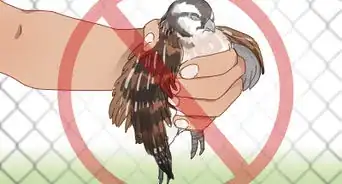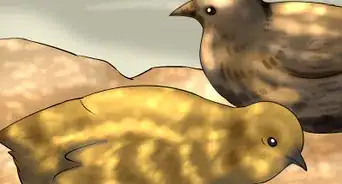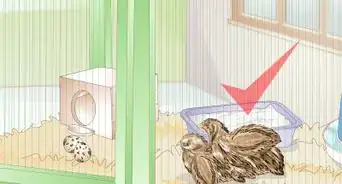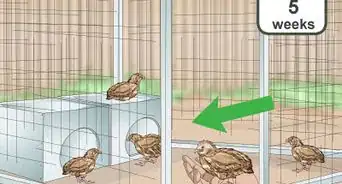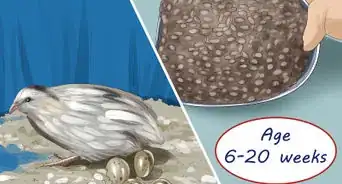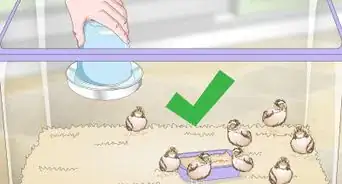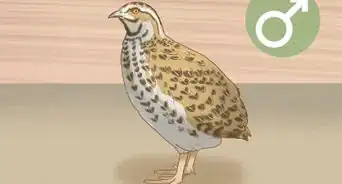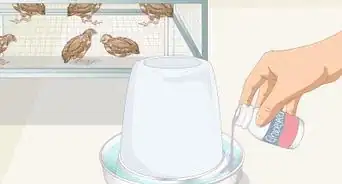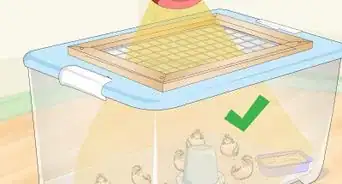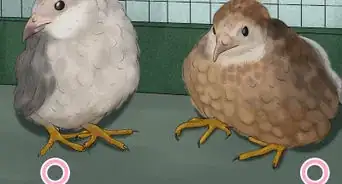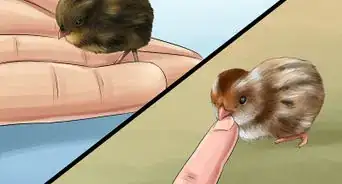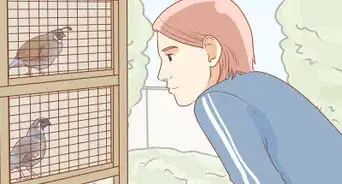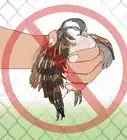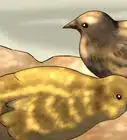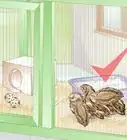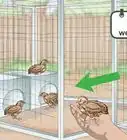This article was co-authored by Pippa Elliott, MRCVS. Dr. Elliott, BVMS, MRCVS is a veterinarian with over 30 years of experience in veterinary surgery and companion animal practice. She graduated from the University of Glasgow in 1987 with a degree in veterinary medicine and surgery. She has worked at the same animal clinic in her hometown for over 20 years.
There are 12 references cited in this article, which can be found at the bottom of the page.
This article has been viewed 15,578 times.
Button quail are usually lively, attractive birds, but a bout with diarrhea can dampen their personality and threaten their overall health. Once you notice any loose stools, reach out to your vet for guidance and follow their dosage instructions for any oral antibiotics. If you are treating your quail at home, isolate any ill birds and clean the cages as often as possible to prevent the spread of the illness.
Steps
Getting Professional Medical Help
-
1Know what normal stool looks like. A typical quail dropping will be brown in color and relatively firm in appearance. It may have some white or light brown spots, but only occasionally. If you see a yellowish or bright greenish dropping, this is unusual and abnormal. Liquidy, runny, or foamy stools are diarrhea and also abnormal.[1]
-
2Get help quickly. When you first see signs of diarrhea, it is important to reach to veterinarian as soon as possible. Some diseases that cause diarrhea, such as ulcerative enteritis, can kill birds within two days of the first signs of sickness. Not eating or getting enough water can be fatal for small birds, such as button quail.[2]Advertisement
-
3Contact your veterinarian. Get ahold of your vet after you’ve first noticed the diarrhea. They will likely conduct a physical examination on any sick birds and perhaps order a complete blood count (CBC) as well. Your vet might request that you bring a stool sample with you, so that they can do a fecal culture. Be prepared to leave your bird overnight for observation, if needed.[3]
- To obtain a stool sample, get an approved container from your vet, use a plastic scraper to pick up some stool from the bottom of the cage, and drop the stool into the container before sealing it tightly. Label the container in permanent marker with your name, the bird’s name, and the date. Wash your hands before and after collecting the sample.
- Depending on the diagnosis, your vet may also suggest more invasive diagnostic procedures, such as an endoscopic viewing of the bowels and intestinal tract.[4] If your bird has intestinal worms that are causing the diarrhea, a procedure like this will confirm it. Speak to your vet about appropriate deworming of your bird if this is the case.
- A vet will also try to rule out any more serious conditions that can transfer to humans, such as botulism. With this illness a bird will be partially paralyzed, but continue to pass diarrhea.[5]
-
4Add an antibiotic to the water. Your vet may give you oral antibiotic drops that you can place directly into the feeder. Pay attention to any dosage guidelines provided by your vet. It may be necessary to clean out your water feeder more frequently to prevent any accumulation of the medicine. Check with your vet.[6]
- Bacterial digestive ailments, such as coccidiosis, are often treated with antibiotic drops.
Making Dietary Changes
-
1Tailor feed according to age. Giving the wrong food for a particular stage in life can trigger diarrhea and protein shortage. Young quail will usually require a starter crumb with a high protein content. Then, at about six weeks old, switch them to a grower/finisher ration designed to help with the maturation process. At ten weeks of age you can transition to a breeder’s feed or a pellet mix with at least 18% protein.[7]
- You don’t have to worry about overfeeding button quail as they are quite good at self-regulating.
-
2Avoid high sugar or rich treats. Limit the treats that you give your quail to only 10% or less of their total food intake. Go for healthy, quality treats, such as spinach. Do not give your quail chocolate, caffeine, or rich foods, like avocado. These foods can irritate the intestinal tract of your birds and lead to stomach upset and diarrhea.
-
3Incorporate some herbs into your quails’ diet. Add a dash of cinnamon, oregano, or garlic on top of their daily meals. Or, put a few drops of liquid oregano oil into their water dishes. Mix some minced garlic in with solid foods. Some quail even like to eat fresh oregano leaves, and these can provide a needed intestinal cleanser and nutritional boost as well.
- For button quail suffering from diarrhea, you can also brew a batch of green tea and offer some in the water feeder.
-
4Give them a vitamin supplement. Buy a powdered supplement from your local pet store or get one from your vet. Mix this powder into food, such as mealworms, which your quail are almost guaranteed to eat. Do this for any sick birds as well as those that are still healthy as a preventative measure.[8]
- Check with your vet before starting a vitamin regimen for your quail. You are generally looking for a supplement that contains high levels of both calcium and vitamin D.
-
5Provide high-quality live food. Quail can get many nutrients from roughage and pellet-style food. But, live food, such as crickets and fly larvae, provide an extra level of digestive protection. Just make sure to not overdo it with the live food and keep the portions small. For example, six mealworms per bird per day is plenty.[9]
- Don’t ever feed your quail insects that you’ve caught outside. These bugs can be covered in pesticides.
-
6Provide ample fresh greens. Slice up a tomato or cucumber. Throw in a few bean sprouts or chunks of broccoli. Toss all of this into a few food bowls designated just for fresh greens. When the birds have their share, remove the dishes immediately. Providing this type of roughage can help clean the gut of your birds and keep them more regular.[10]
Preventing the Spread of Infection
-
1Wash your hands before and after handling. Hold your hands under warm water and lather up with soap for at least 20 seconds. Or, use a hand sanitizer solution with at least 60% alcohol content. Repeat this process both before and after handling your quail. This will prevent any infections from spreading to you and vice versa.[11]
- Chlamydiosis is one diarrhea-causing infection that quail can carry and transfer to humans. Washing your hands will limit the possibility of transfer.[12]
-
2Isolate any sick quail. It is quite possible that whatever illness is causing the diarrhea can be spread rather quickly through direct or indirect contact between birds. Once you notice that one of your quail is acting sick, take it out and place it into a separate, clean cage far away from the rest of the flock. This will also make it easier to keep up with regular cleanings.[13]
-
3Quarantine new birds. Have a cage set aside as a receiving area for new birds to your flock. Keep any new arrivals in this more isolated cage for about two weeks or so. This will give you ample time to check out the bird’s health and to determine whether or not it is okay to place with your other quail. You’ll also have time to get it checked out by a vet, if desired.
-
4Clean all food and water bowls regularly. For the infected bird, take out all feeders and rinse them two to three times per week. For healthy quail, it is generally fine to clean all feeders once a week when the temperature is moderate or cool and a little more often when the weather is hot and bacteria are breeding more quickly. But, take out a feeder for cleaning if it makes contact with any feces. Or, if the food in the dish has turned moldy or rotten.[14]
- Quail, like humans, can get salmonella from unclean or rotten foodstuffs or polluted water. This illness often causes diarrhea.
- Some infectious causes of diarrhea can be spread by contact with feces, infected birds, and also biting flies. Because of this, it’s essential to maintain clean hygienic conditions at all times so that flies are not attracted to the area and fecal soiling is removed.[15]
-
5Remove any waste quickly. Keeping a clean environment is critical to stopping the spread of whatever illness is causing the diarrhea and preventing a recurrence. Clean off any feces that you see on a daily basis. Then, scrub down the interior of the cage or roost with a 50-50 vinegar and water solution two to three times a week.[16]
- Keeping feces from accumulating on the floor will also prevent other illnesses, such as bumblefoot, a bacterial infection of the feet caused by contact with stool.
Warnings
- It’s a good policy for immune compromised individuals to limit contact with button quail, especially if any of the birds are sick.⧼thumbs_response⧽
References
- ↑ https://poultrykeeper.com/digestive-system-problems/diarrhoea-backyard-chickens/
- ↑ https://www.backyardchickens.com/articles/quail-diseases-health-issues-and-keeping-your-quail-healthy.67379/
- ↑ https://www.cdc.gov/healthypets/pets/farm-animals/backyard-poultry.html
- ↑ http://www.petplace.com/article/birds/general/when-your-bird-is-sick/diarrhea-in-birds
- ↑ https://www.cdc.gov/healthypets/pets/farm-animals/backyard-poultry.html
- ↑ http://www.chickens.allotment-garden.org/keeping-quail/keeping-quail-eggs-and-health/
- ↑ https://poultrykeeper.com/general-quail/beginners-guide-to-keeping-quail/
- ↑ https://www.beautyofbirds.com/buttonquails.html
- ↑ http://www.cyberquail.com/homepage.html#FEED
- ↑ http://www.cyberquail.com/homepage.html#FEED
- ↑ https://www.cdc.gov/healthywater/hygiene/hand/index.html
- ↑ https://www.petco.com/content/petco/PetcoStore/en_US/pet-services/resource-center/caresheets/button-quail.html
- ↑ http://www.hobbyfarms.com/quail-raising-tips/
- ↑ http://www.hobbyfarms.com/quail-raising-tips/
- ↑ http://www.thepoultrysite.com/diseaseinfo/162/ulcerative-enteritis-quail-disease/
- ↑ https://www.backyardchickens.com/articles/quail-diseases-health-issues-and-keeping-your-quail-healthy.67379/
About This Article
To treat diarrhea in your button quail, first visit your vet, since diarrhea can indicate many different types of illnesses. Once your button quail has been diagnosed, you may have to use a dropper to give it antibiotic drops, which are used to treat a bacterial infection. Your vet might also suggest that you change your quail’s diet. For example, if your quail is young, it may need a starter crumb with higher protein levels to keep it healthy. Additionally, you may have to cut back on rich treats like chocolate or avocado which can upset your quail’s stomach. To learn how to prevent the rest of your flock from getting sick, read more from our Veterinary co-author.















